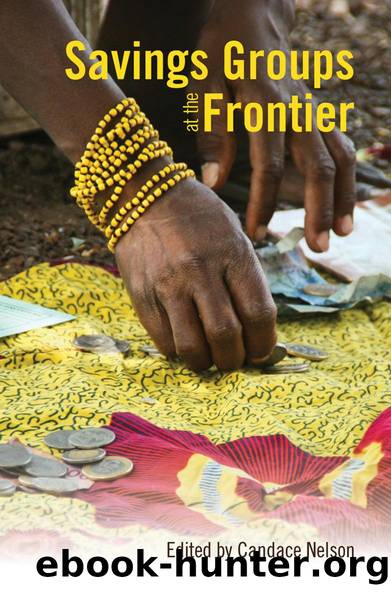Savings Groups at the Frontier by Candace Nelson

Author:Candace Nelson [Nelson, Candace]
Language: eng
Format: epub
ISBN: 9781853397769
Barnesnoble:
Publisher: Practical Action Publishing
Published: 2013-01-15T00:00:00+00:00
Savings as percentage of loans outstanding (%)
155.5
166.3
Savings per member, as percentage of GNI per capita (%)
7.0
8.5
Average outstanding loan size, as percentage of GNI per capita (%)
6.3
8.0
Members with loans outstanding (%)
46.4
41.0
Loans outstanding as percentage of performing assets (%)
51.6
49.8
Annualized return on assets
37.5
44.4
Source: www.thesavix.org
What is becoming clear, however, is that CBTs paid by the groups they train may be out-performing paid project staff in terms of key performance indicators. Taken on average, groups trained by CBTs appear to mobilize more savings, have members who tend to borrow in larger amounts, and are more profitable (see Table 3.2).
Outsourced CBTs (CAREâs COSALO model)
CAREâs COSALO project in Kenya pioneered a model through which many of the functions of group formation were outsourced to local entrepreneurs and faith-based organizations (FBOs) that contracted and supervised SG trainers. CARE paid a commission per member trained, which was divided between the trainer and the entrepreneur or FBO. The project reported remarkable output, with the cost per member well under $10. In some cases, the entrepreneurs and their trainers found innovative ways to train groups as quickly as possible to gain the greatest commissions. Some of the positive innovations include the massive clustering of groups to both reduce the number of visits and encourage inter-group learning, the use of radio spots, and systematic visits to weekly markets to recruit new groups. Other innovations â including emphasis on monthly rather than weekly meetings, the optional use of lockboxes, and the adoption of a uniform savings amount for all members in place of the variable and flexible share system â cut corners in ways that were probably not in the membersâ best interests. Yet, despite some flaws, the remarkable efficiency of outsourcing makes it a possible model for other projects.
Community-driven delivery channel
When savings groups are introduced into an area, very often, members go on to form other groups. This often happens without the awareness of the FA or project. Two studies in western Kenya have shown the scope of this phenomenon. In one district, Odell and Rippey (2011) found 37 groups that had been created by members of the 44 groups formed by CARE.11 In a 2011 study, also in western Kenya, Financial Sector Deepening (FSD) Kenya and Digital Divide Data specifically looked for evidence of replication in a sample of 54 groups. They found that âReplication was the norm, with the average group creating nearly two additional groups in the 14 months since the project ended. Three-quarters of all groups had replicatedâ (FSD/Digital Divide Data, 2011). It is not known to what extent western Kenya is representative of other parts of the world, of course, but most projects have shown some evidence of community-driven group formation.
Even before SfC started employing the volunteer model described in the section above, it reported an annually compounded rate of group-to group formation that exceeded 30 per cent in Mali.12 Realizing the promise of this model, SfC shifted to a community-based trainer model to reach expansion targets under its Gates Foundation grant, which called for programme growth at a rate of 10,000 new members per month.
Download
This site does not store any files on its server. We only index and link to content provided by other sites. Please contact the content providers to delete copyright contents if any and email us, we'll remove relevant links or contents immediately.
International Integration of the Brazilian Economy by Elias C. Grivoyannis(90776)
The Radium Girls by Kate Moore(11921)
Turbulence by E. J. Noyes(7935)
Nudge - Improving Decisions about Health, Wealth, and Happiness by Thaler Sunstein(7615)
The Black Swan by Nassim Nicholas Taleb(7010)
Rich Dad Poor Dad by Robert T. Kiyosaki(6399)
Pioneering Portfolio Management by David F. Swensen(6226)
Man-made Catastrophes and Risk Information Concealment by Dmitry Chernov & Didier Sornette(5921)
Zero to One by Peter Thiel(5684)
Secrecy World by Jake Bernstein(4643)
Millionaire: The Philanderer, Gambler, and Duelist Who Invented Modern Finance by Janet Gleeson(4374)
The Age of Surveillance Capitalism by Shoshana Zuboff(4209)
Skin in the Game by Nassim Nicholas Taleb(4161)
Bullshit Jobs by David Graeber(4094)
The Money Culture by Michael Lewis(4075)
Skin in the Game: Hidden Asymmetries in Daily Life by Nassim Nicholas Taleb(3929)
The Dhandho Investor by Mohnish Pabrai(3698)
The Wisdom of Finance by Mihir Desai(3650)
Blockchain Basics by Daniel Drescher(3501)
